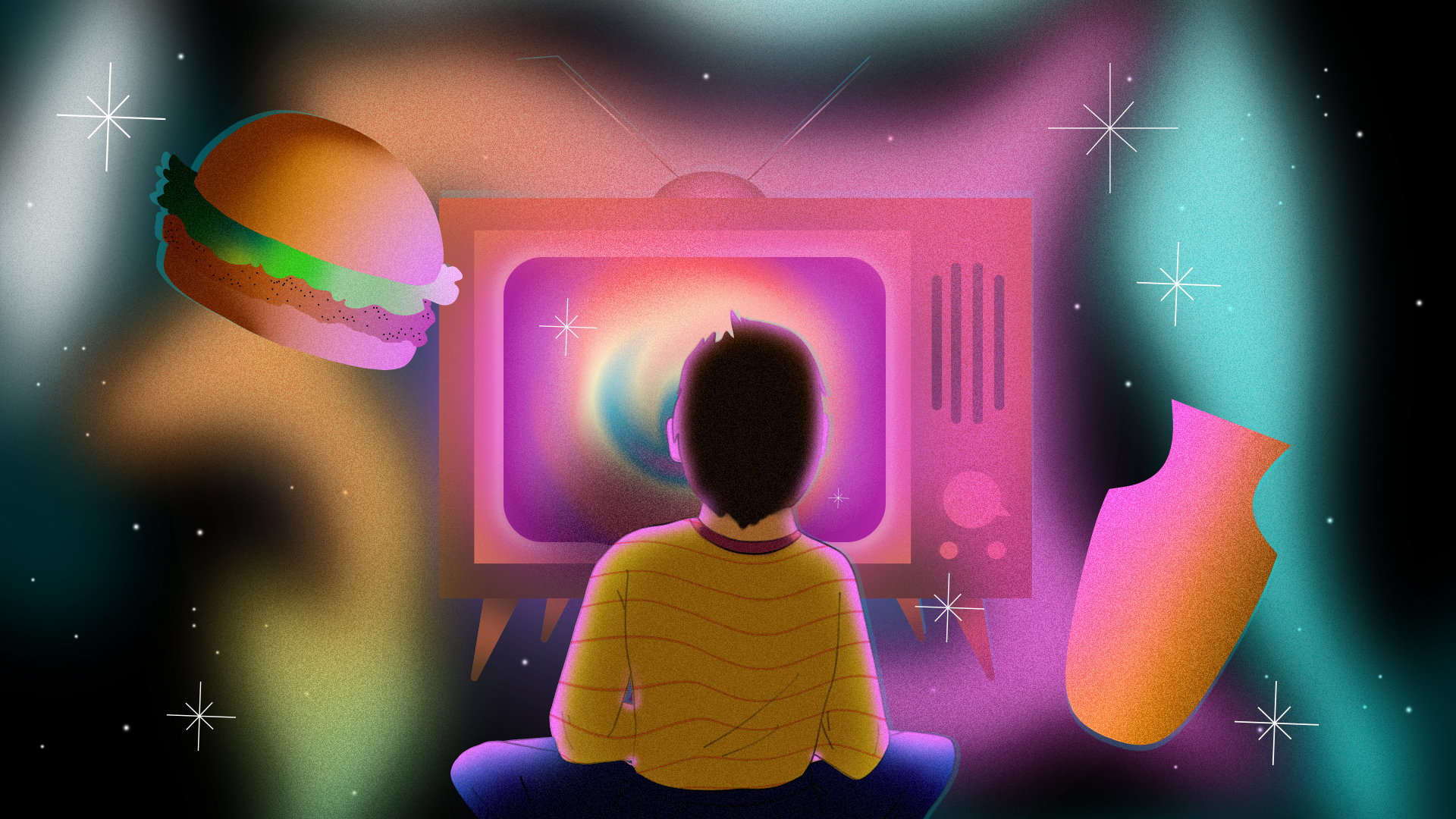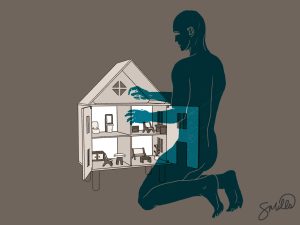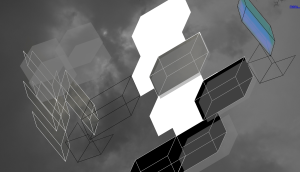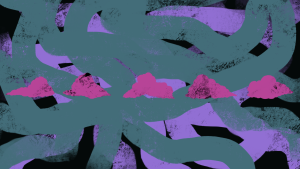“Wildcats” is raw, anarchic performance and I don’t have much to say about it — I can’t talk about creators Ida Cuttler and Nick Hart’s experiences and try to mine them for some secret shadowy wisdom, lining the inside of the fur coat that is “Wildcats,” which, basically, is a drag-poem collage performance adapting and interpreting Lucille Ball’s first, last, and only Broadway performance, the 1961 show “Wildcat,” — catastrophic or aspirational, depending on who you ask — drawing heavily from the iconography of “I Love Lucy.”
In any case, that’s pretty much all I have to say about it, but it reminded me of a way in which I love performance and art… so I’ll talk a bit more.
The bare “State Park” (the Neofuturists’ lobby, that is) has three projections of “I Love Lucy” playing on three walls, the sitcom’s antics mirrored down the center looking like ecstatic Rorschach tests; midrange-techno music calls us into the theater which contains another projection of “Lucy,” this one filtered through candy-colored blues and pinks, oscillating slowly across what scientists call the Rave Spectrum [citation not found].
First, Nick hangs up his mask after a long day out on the job of being alive today. Second, he tells us the story of how he ate a Popeye’s chicken sandwich everyday during the early months of the pandemic. Then, Ida hangs up her mask (everybody’s working hard these days) and tells us about playing backgammon with her husband in the early days of the pandemic:
“Sometimes you’re almost off to the races, you’ve almost won, and a piece gets captured and sent to the middle where it has to wait; trapped, and unable to go anywhere, for a very, very long time.
Eventually the exact number of spaces are rolled on a die and the man is released from his isolation, only to frustratingly have to go around the entire board, and start all over again.”
Remember this. It’s important for later.
Anyway, I loved “Wildcats,” despite hating “I Love Lucy.” I remember waking up at my Auntie Di’s place at 10:30 pm when I was eight or nine and quietly watching the soapy glow of the TV on Di’s face in her tiny suburban apartment with two cats (one who righteously hissed at me, wrong-stepping into their home) and watching an episode (I couldn’t tell you which, they all blur together in a slog of live studio audiences and dead-eyed mugs to the camera), thinking “Why are you laughing? Why are you laughing?” in the miasmatic, perfectly lucid way a child thinks and feels.
Ida and Nick ask the same question, but they ask it from inside the sitcom. A particularly offensive joke about Lucy’s neighbors Fred and Ethel not being people inspires a little extra rebuke, “WOAH, WOAH, DID YOU JUST LAUGH AT THAT?” Ida shouts at us. The consciousness has changed in the last 60 years and much more in the last six. How could “I Love Corona” — I mean “Lucy,” — not change?
I admit, I have a chip on my shoulder about the laugh track. The pandemic wasn’t worse than life before (for me) — when we all went inside, I was already so far inside that my skin was a cathedral collapsing around me. One of the last days — before doors locked and we started lubing up our groceries with geranium-scented hand sanitizer — I was sobbing in a bar over an email wondering what was left, how to be brave.
Nick Hart is brave, Ida Cuttler is brave, and the pair of them share an aggressively stupid sense of humor: these two know how to leverage an empty head and re-balance any scale in favor of a good laugh, even if it’s just them arching their bodies and rhythmically humping the leather couch at the center of the stage like loud, horny, tandem cycling oil rigs. When anybody says Joe Dynamite, the one-woman orchestra, Laura McKenzie, shakes a thunder tube.
Joe Dynamite. Joe Dynamite. Joooooe Dynamiiiiite is Wildcat “Wildy” Jackson’s love interest. That’s “Wildcat” starring Lucille Ball in her first, last, disastrous (or maybe aspirational?) live theater performance which ran for 171 performances. For context, the average Broadway musical was somewhere in the 300s. Nonetheless, Ball did it, just as Nick and Ida do it here — kinda. They recreate the musical insomuch as they can, or want to. Nick is more interested in the obliterative retelling of the musical as a disaster (the crew for Ball’s show had to keep a respirator backstage for her; she had five fainting spells doing the show and a host of other injuries) and the puissant liberatory practice of honest-to-god revelatory ritualistic destruction, whereas Ida sees it as an opportunity for setting the record straight (see: “Comfortable Shoes”) and doing the musical for what it could’ve been, what it meant for a freshly divorced Lucille Ball in the era following “I Love Lucy”; what it could be to do something right and perfect and new and exciting.
Really, in some ways, this question has a hidden suggestion, setting up the biggest question theater companies (and, by corollary, almost all theater makers) have these days: what the fuck are we doing this for?
It’s a relevant question in the theater world: companies have no coherent logic or community binding them together beyond their nature as non-profit entities concerned with Legacy; season announcements come out and betray us with the idiocy and untimeliness of their content (I won’t say art) and hold onto insubstantial labor practices after years of saying Black Lives Matter and acknowledging indigenous land rights; as they continue to fall into the cycles of production which creatively satisfy few, apart from their season ticket holders, pissing negronis and digesting cultural artifacts with the voracity of parasitic wasp larva, suckling the inside of an institution (“dear, this caterpillar flesh is divine”) before abandoning the theater with no opinions challenged, no feelings inspired (except the easiest, most reflexive ones) and still happily fulfilling their cultural obligations. They have currency now, in the uncanny facsimile of something like an experience. For years, I’ve reviewed theater that claimed in its marketing and shownotes its own importance, immediacy, or — I shudder at the word — urgency.
The truth is usually more simple than that, simple enough to just say, “Yeah. I just wanted to do it. I had a friend and I really wanted to make something with them and I really wanted to make pure chaos and feel pleasure like I could do something good and perfect and beautiful.”
But then again as Nick says:
“There is a very large sign outside of this theatre that says ‘you are beautiful’. They are found all over the city. YOU ARE BEAUTIFUL.
No. You’re not. You are not beautiful. You just aren’t.
Beautiful. Is. Simple. And it is Boring.”NH throws a vase to IC off stage.
And to be honest, I really expected that vase — I mean, that terracotta pot — to hit the floor and break.
“BREAK MY LEGS,” Nick insists.
“I just think it would be an OSHA violation if I purposely broke your leg while we’re both working,” Ida points out.
Not ten minutes later, Nick, walks through the state park, the lobby, backstage, the ticketbooth screaming about his (un)broken leg while we all wait patiently in the theater and when he gets back, he smokes a cigarette in the theater, committing an OSHA violation (“this theater has a storied tradition of OSHA violations,” he shouts as the projector displays a history of not-every-injury suffered) and, thus, this show can never win a Jeff award. To be honest, it’s a trivial credit when the show speaks so well for itself.
For example, whenever Laura mentions the past, her tongue slips. 1961, the year of our corona. We look at the past through the lens of the present and everything that’s happened since. It is, after all, impossible to escape the present and nostalgia is merely (mirrorly?) a funhouse mirror. The mirrors that Ida and Nick hold and angle constellate into systems of reflection, articulating the differences between then and now, this and that, beauty and interest, between loneliness and discomfort, between saying something and meaning something.
But it’s also more than that. It’s Ida and Nick collaborating, it’s the performance of a storied friendship. These two have been working together for six years and they’ve played each other’s partner more than once and, in fact, many, many times. This show fulfilled something for them that was almost impossible to fulfill these past two years. In the program note, Ida says that she and Nick are performing past versions of themselves. Who isn’t these days? As the country and Chicago reopen, so many of us have put our hustle shoes back on, corralling ourselves back into the grind because the government and circumstances have given us so little else to do but revert to how things were, even though nothing is the same. I’m not the same. The climate’s not the same.
I don’t think gasoline fires are as bad as climate change, but their devastation is concentrated on the person at the site of the fire; it’s like a microcosm of the rest of the world. According to Nick Hart, the second top comment on a YouTube video for Bobby Vitton’s “Mr. Lonely” is about a woman’s father dying in a gasoline fire. “Yes, I guess it’s lonely in a gasoline fire,” says Nick.
My life felt like a gasoline fire. When my therapist and I had our last session, she said that, after our first month together, she didn’t know how to help me, but she was talking to me, helping me build a story from the pieces that I didn’t know how to arrange anymore.
One of the strangest things about coming back to a theater after the initial waves of the pandemic is how much less I care. There have very definitely been emotional moments of just being in a space with people performing, but there’s also this nagging sense that the urgency has never been urgent. The immediacy has rarely been immediate — except again, in the unique circumstances that the Neofuturists exacerbate, where the audience is the precondition, the world and artists’ lives are the context.
Even as an active participant in the field, as an administrator and practitioner, I find the industry’s attempts to validate its own existence while making a “profit” cloying and disingenuous: over here, artists are hardly ever artists, actors lack agency to choose their direction, directors and playwrights and experimental artists have no in-roads; “anti-racist” policies are corporately incongruous, often resembling DEI trainings and then business as usual; and the shows still suck (mostly). It’s like — and I’ll ask you to remember backgammon — it’s like we went to the races and now we’re stuck in the middle of the board, waiting for the stars to align or the dice to roll or the industry to finally understand. But I don’t wanna play this game anymore. I want to make art with people who want to do it, not those obligated by their career choice. And I don’t want to be stuck in the middle of an industry that doesn’t care about me, my friends, or my art.
But Nick and Ida? They have perspective. They’re interesting. They make me want to make theater again, they make me believe in individual relationships inside of a society that rejects notions of community.
If I could pin it to a phrase, “Wildcats” is a constellative, drag, fever poem dreamt around the shape of Lucille Ball’s “Wildcat” where every song, stanza, or enjambment brims with parentheticals and is furiously footnoted by Nick and Ida’s context of this, the nightmare we collectively live now, assigning a cosmology to the Wildcat — impossible to catch, but demanding a chase. For Ida, it’s the beautiful ambition of something new and challenging. For Nick, it’s the purifying destruction. For both, it’s always just out of reach…unless maybe you have a friend holding your hand as you stretch your arm over the edge of the abyss.
Nick and Ida, Ida and Nick pushing and pulling, creating and destroying in a mythic cycle of jokes and cigarettes and loneliness and friendship and sitcoms. “Wildcats” is an acknowledgment and interrogation of what we make art for and how it’s just as often a pretext for meaningful relationships as much as a byproduct of those same relationships. And it is a wildly stupid, powerful usage of Ida and Nick’s charisma, humor, and wit.
Ida and Nick, the swinging pendulum. Ida and Nick, two friends being friends.
You know, maybe we’ll be ok. As long as we’ve got each other.
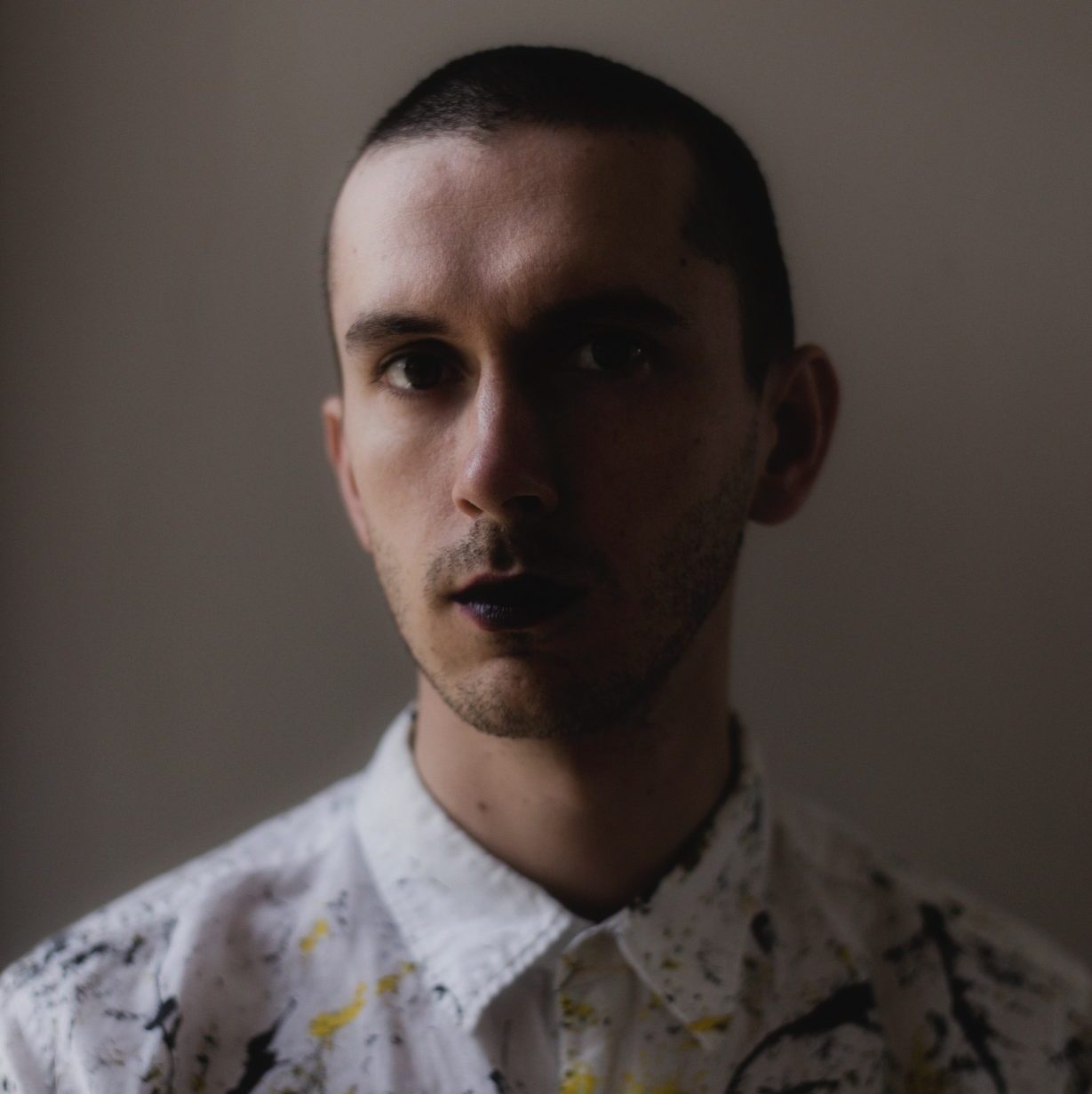
About the Author: persephone van ort (they/it) is a trans, white artist, writer, and administrator living in colonized Chicago/zhigagoong. Its work has been featured with the Neofuturists, the Wender Collective, and others. It writes about time, crisis, and dreams, while making performance about social order, culture, and bodies. Headshot by Ryan Thiel.
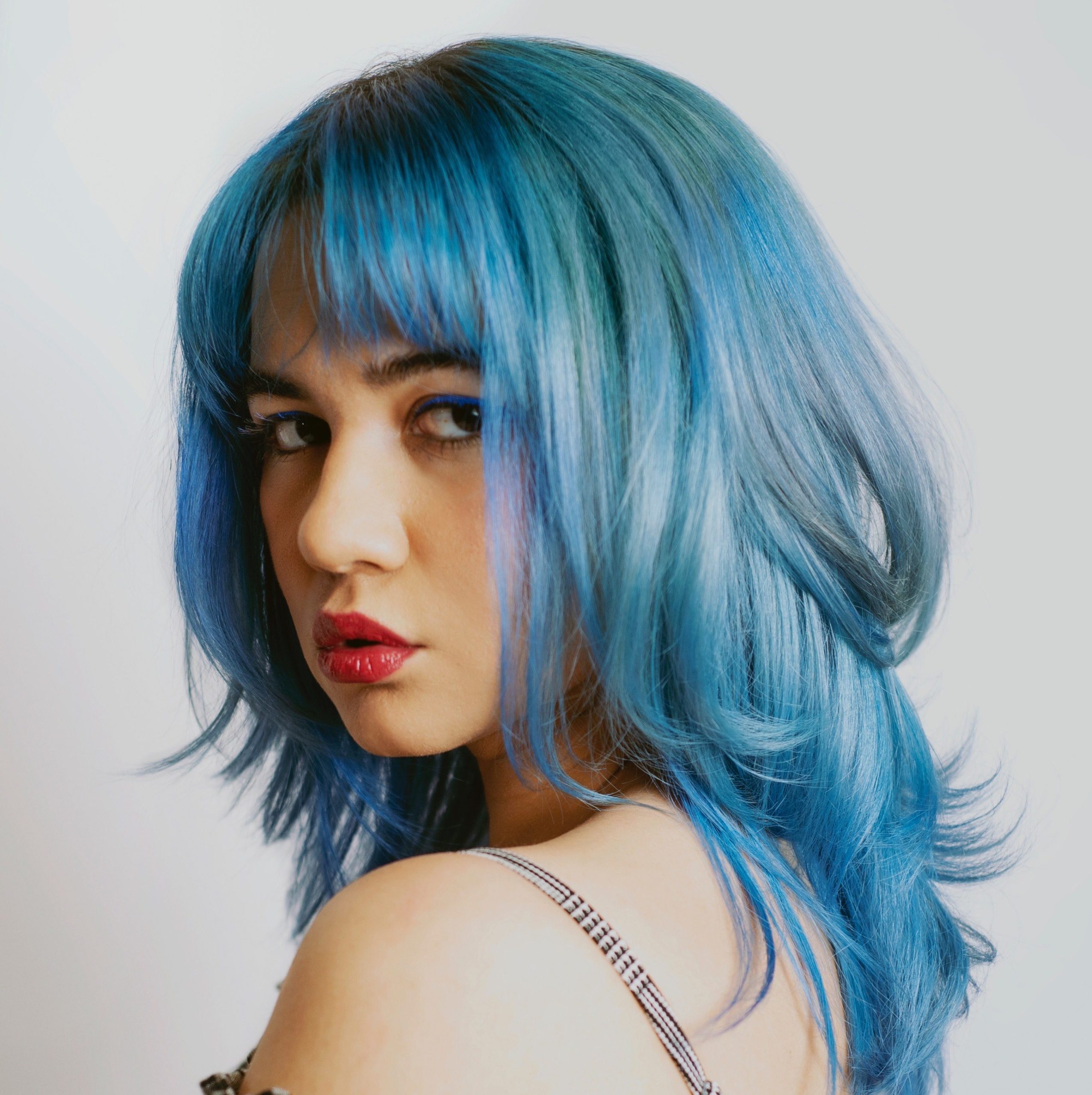
About the Illustrator: Diana C Pietrzyk is a multidimensional creative from Chicago with a love for things that twinkle and glow. She explores her passion through illustration, painting, photography, graphic design and animation. Her style is very colorful, fun and glows.
